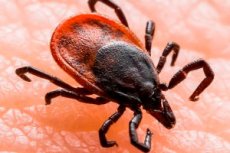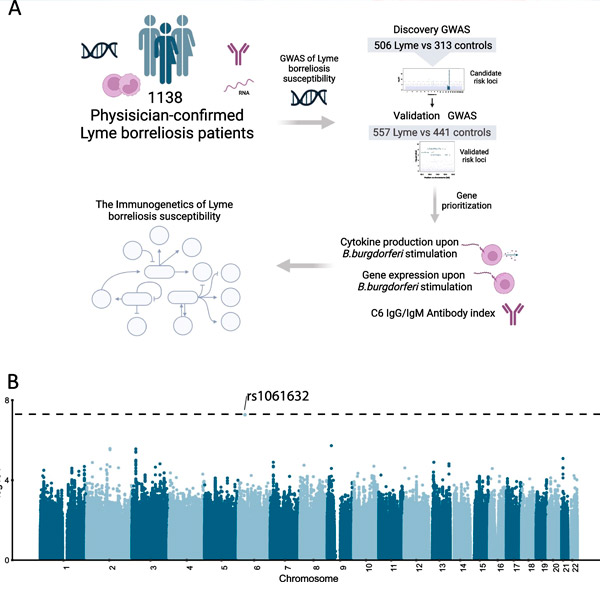New publications
The likelihood of developing Lyme disease depends on genetics
Last reviewed: 02.07.2025

All iLive content is medically reviewed or fact checked to ensure as much factual accuracy as possible.
We have strict sourcing guidelines and only link to reputable media sites, academic research institutions and, whenever possible, medically peer reviewed studies. Note that the numbers in parentheses ([1], [2], etc.) are clickable links to these studies.
If you feel that any of our content is inaccurate, out-of-date, or otherwise questionable, please select it and press Ctrl + Enter.

Lyme disease is the most common tick-borne disease in Germany. It is not yet well understood whether a certain genetic predisposition plays a role in the development of the disease and which immunological processes in the body are involved.
A research team from the Centre for Individualised Infection Medicine (CiiM), a joint institution of the Helmholtz Centre for Infection Research (HZI) and the Hannover Medical School (MHH), in collaboration with Radboud University Hospital and the Amsterdam University Medical Centre (both in the Netherlands) have now discovered the responsible genetic variant and the immune parameters involved.
If the tick is infected with the pathogen Borrelia burgdorferi sl (sensu lato = in the broad sense), these bacteria can be transmitted to humans through the tick bite and cause disease. Various organs can be affected: skin, nervous system or joints.
"Borrelia infection does not always lead to disease, and in the case of Lyme disease it can usually be successfully treated with antibiotics. However, as our collaborating partners have found, some affected individuals develop persistent symptoms such as fatigue, cognitive impairment or pain despite antibiotic treatment," says Professor Yang Lee, Director of CiiM and Head of the Bioinformatics for Personalised Medicine Unit at HZI.
"To find additional starting points for the development of effective therapies for the treatment of Lyme disease in the future, it is important to better understand the genetic and immunological mechanisms responsible for the development of the disease."
In this direction, the research team analyzed the genetic patterns of more than 1,000 patients with Lyme disease and compared them with the genetic patterns of uninfected people. "The goal was to identify specific genetic variants directly associated with the disease," explains Javier Botey-Bataller, a researcher at CiiM and one of the first authors of the two studies.
"We have actually identified a specific, previously unknown genetic variant in patients with Lyme disease."

Identification of the rs1061632 variant associated with LB susceptibility. Cohort overview. 1107 DNA samples from LB patients were available for quality check and imputation, leaving a discovery cohort (n = 506) and a validation cohort (n = 557). B Manhattan plot of genome-wide significant variants associated with LB susceptibility in the discovery cohort. Credit: BMC Infectious Diseases (2024). DOI: 10.1186/s12879-024-09217-z
The research team conducted various cell biology and immunology tests to find out what specific physiological consequences this genetic predisposition has.
"On the one hand, we were able to show that anti-inflammatory processes in the body are reduced in the presence of this genetic variant. This means that inflammation and symptoms of Lyme disease may last longer," explains Lee.
The researchers also found that patients with this genetic variant had significantly reduced levels of antibodies against Borrelia, suggesting that as a result the bacteria cannot be attacked effectively, making the illness last longer.
"We were also able to identify 34 different gene loci that are involved in regulating the immune response of patients with Lyme disease through mediators such as cytokines, and that may also play an important role in other immune-mediated diseases such as allergies," says Boteil-Bataille.
In the study, all the genes in the human genome are written down in what is called a genetic map. Each gene has its own unique position, called a gene locus. "Our study results clearly show how the immune response is determined by genetics," says Lee.
"Because our study results are based on an extremely broad database due to the large cohort, they provide an excellent basis for further research approaches, for example, to study the impact of different variants of the involved genes on the severity of Lyme disease."
The incidence of Lyme disease has increased in the Northern Hemisphere in recent years. The research team suggests that further increases can be expected in the future, even with climate change. This is because generally milder temperatures can extend the tick season and increase their range.
The result: more tick bites and, therefore, more possible cases of Lyme disease. "Our findings provide important insights into the genetic and immunological processes that contribute to the development of Lyme disease. We hope to pave the way for the development of effective treatments for Lyme disease sufferers with long-term symptoms," says Lee.
The researchers published their findings in two studies, one in the journal Nature Communications and the other in BMC Infectious Diseases.
